Hi, I’m Maureen and I work as a product designer and design content creator.
The Cursor Magazine is my online publication on design and career.
TL;DR In this newsletter I analyse if and how Figma’s reputation has changed within the design community, from its rise as the dominant design tool to recent challenges including the failed Adobe acquisition, controversial UI redesign, pricing issues, and emerging competitors like Penpot and AI-powered alternatives that could threaten both Figma's position and the future role of designers. The critiques mentioned in the article do not reflect my opinion on Figma.
New kid on the block
Around 2019 Figma became the design tool of choice within the design community and wiped out Sketch, InVision and Adobe XD seemingly without effort. Figma solved a problem that all of these tools could not solve: seamless connection between design and prototyping in an online, collaborative environment. Designers were eager to embrace a tool that felt truly intuitive, collaborative and above all - free.
Figma was smart enough to utilise the power of communities from the start, bringing together fans all over the world in local “Friends of Figma” chapters and allowing people to share their own templates in the Figma community. With events such as the immensely popular Config, they managed to tie designers even closer to their tool. So close that for some in the design world Figma became synonymous to “UX Design”.
Praise was all around….until it wasn’t anymore.
In the past year I’ve noticed a shift in online discourse. The praise now comes accompanied with critical side-notes and I’ve seen more promotion on open-source alternatives such as Penpot or AI-powered tools.
What happened that changed the discourse around Figma?
I have several theories.
The sell-out that couldn’t sell out
Adobe’s planned acquisition of Figma suddenly made everyone aware of this designer’s tool of choice. A 20$ billion merger - a dazzling amount of money for a small company that at the time was just 10 years old. For Adobe this acquisition would cement them as the biggest player in the design tools market.
It was exactly those concerns for a monopoly that lead EU and UK regulators to raise some eyebrows. The European Commission and the UK Competition and Markets Authority decided that the merger “may reduce competition in the global markets for the supply of interactive product design software and of other creative design software.” As a reaction to these findings, Figma and Adobe then decided together to end the pending acquisition.
Ouch.
Designers were relieved - big uncle Adobe lost. But it left Figma in a vulnerable spot. The cool kid on the block turned into a sell-out. Now, they were the sell-out that…actually couldn’t sell out.
Was this the moment the public discourse shifted? Perhaps, but it couldn’t be the only reason…
UI3 - as uninspiring as its name?
Figma hasn’t been slacking since the failed merger. Last summer Figma presented something big at their immensely popular conference Config: an overhaul of their interface named UI3. While the name was less than inspiring, the UI update did have big aspirations. Figma set out to “reimagine how designers work” and “make Figma Design feel more focused for designers and more approachable for a broad range of users.”
Would this be Figma’s redemption arc?
The redesigned Figma was received with lukewarm reactions. Just a quick browse through Reddit’s /FigmaDesign and /UXDesign will show you a bunch of threads critiquing the redesign. The main points of critique seem to be:
The new floating panels are seen as intrusive, as they overlap with the canvas content and disrupt the design workflow.
UI relocated essential features, making it hard to find them.
Common actions like clipping content or applying auto layout take more clicks, which introduces friction and reduces overall productivity.
In addition to the criticism that followed the UI3 update, there has also been increasing critique about Figma’s confusing pricing strategy. Recent price updates led people to complain and question Figma’s pricing plan on platforms such as LinkedIn and Reddit.
These price changes especially affect freelancers and developers. For freelancers the use of Figma can quickly become very costly, as freelancers need to book additional seats for each client they work with. While Figma focused on developers by releasing their Dev Mode earlier, they now risk losing this segment since they turned this mode into a paid feature in January 2024. As teams usually consists of more developers than designers, this quickly rakes up the price for Figma seats and impacts the adoption of the tool among developers.
It’s clear that a redesign will not please everyone and price increases are never met with enthusiasm. However, if the group that is unhappy with current changes is big enough and consists of those who advocate tools within their company it can become an actual threat for Figma. That leads me to another point: Figma’s competitors.
One day you’re in, the next you’re out.
If we’d ask Heidi Klum, she would agree that there’s one thing fashion models and design tools share: one day you’re in, the next you’re out.
It happened to Sketch. It happened to InVision. And, I hate to say this, it’s a matter of time until it happens to Figma.
For years, there were no alternatives that came even close to the experience Figma delivers to its users. Today, new (AI-powered) design tools come up that actually are viable alternatives that could fill Figma’s boots.
One of those tools is Penpot, an open-source design tool with a very generous free plan (unlimited design files, anyone?). Penpot saw a 5,600% growth to 100,000 users in 2022 as a result of figma’s planned merger with Adobe. As of April 2024, Penpot reported having over 600,000 users.
It’s not just designers who have new Figma alternatives on their hands. There is online discourse that questions the need of design software (and designers) as a whole. No-code or AI-powered builders such as Framer, Vercel’s v0 entered the scene and enable (non)designers to quickly build apps and websites with minimal or no involvement of designers. Recently, my LinkedIn feed has been looking like this:
and co-founder of Y Combinator and influential programmer and essayist Paul Graham recently shared this on X:
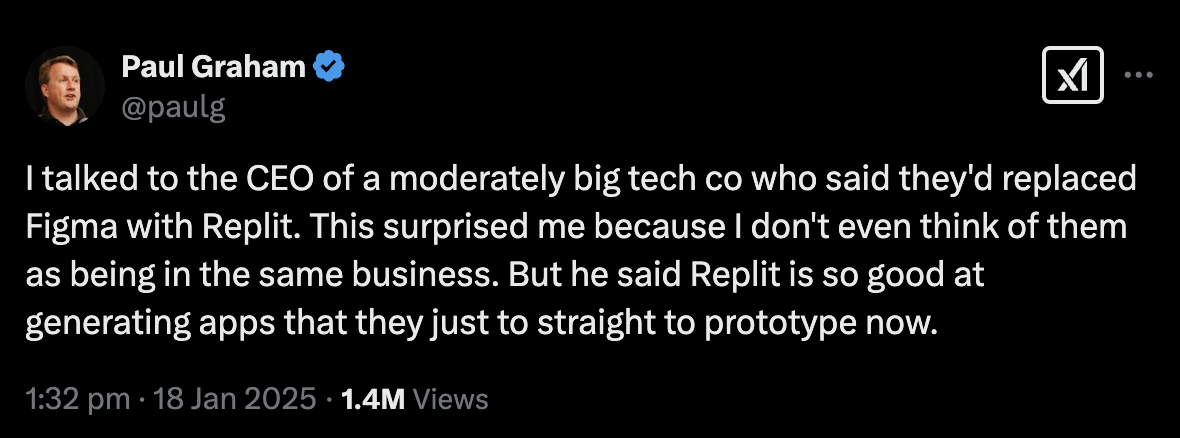
When such influential figures share these kind of statements, I think we should pay attention. Not necessarily because they know a truth we don’t know, but because it can show us bigger trends. AI-powered tools enable people to quickly prototype or ship products, which naturally makes people question why we would spend time designing in Figma at all. By proxy that also opens the discussion if we need designers in the future and to what capacity.
With design alternatives like Penpot or tools that seemingly make design software obsolete, stepping away from Figma is easier than it seemed before.
Conclusion
Does that mean Figma is on it’s way out? Far from it. This survey of UX Tools shows that Figma still is the designer’s tool of choice with a distance:
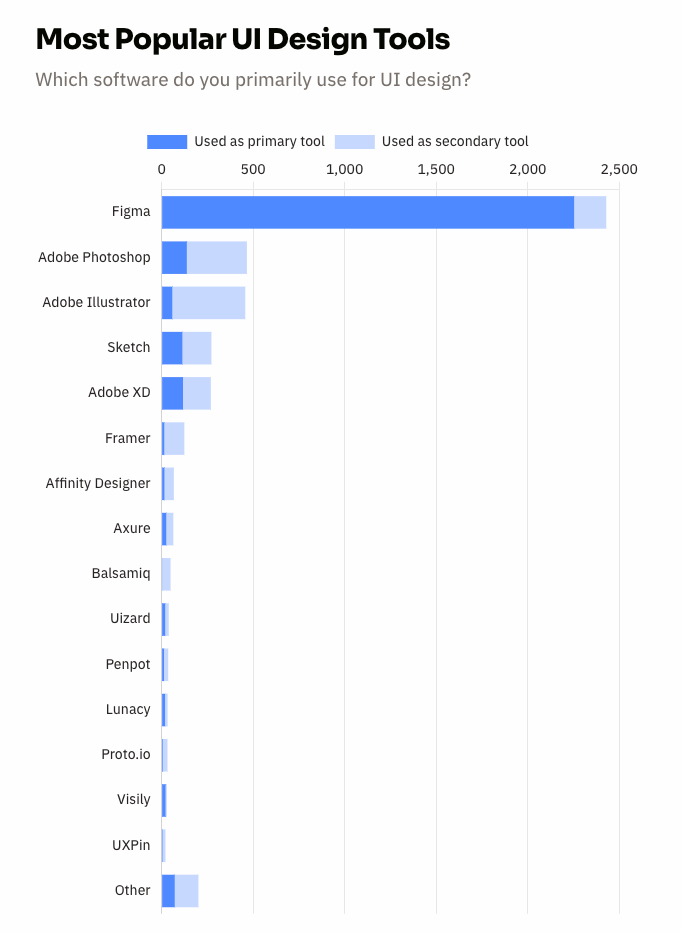
With the diversification of their platform (Figjam, Figma Dev Mode) we can see that Figma is now also trying to appeal to engineers and product teams.
However, I do see a couple of threats that could hurt Figma’s position in the future. Figma’s pricing doesn’t feel justified by many designers and could lead them to explore alternatives like the open-source Penpot.
Figma’s focus on product and engineering roles could lead to having less eye for their users from day one: designers. Frankly, Figma isn’t the only tool that’s focusing it’s efforts on catering to non-designers. Even more so, more and more tools focus on enabling product teams to create designs without the help of a designer or design skills. Tools like Vercel or Framer skip the need to create designs first entirely and go straight to building functioning websites using the interface we’ve come to know from Figma.
In that regard, it might not be Figma that’s the loser in this story. It might, after all, be us - the designers.
I would love to hear your thoughts on this - has your view on Figma changed over the years?
In the next publication: The Soft Skill Designer
I’ll explore what ‘craft’ means for designers and why I believe soft skills will become essential in the designer’s toolkit.
Recommended reading and sources
This LinkedIn post by Jessice Ritchie inspired me to write this article.
For my research I referred the following Reddit threads:
I also referred the following articles:
While doing research for this article, I came across an article that Jan Takacs wrote in September 2024 where he analyses Figma’s developments from a business perspective. I think it’s a very interesting article and recommend you give it a read!
Last but not least….
This post is written by me with the support of ChatGPT to summarise Reddit threads.




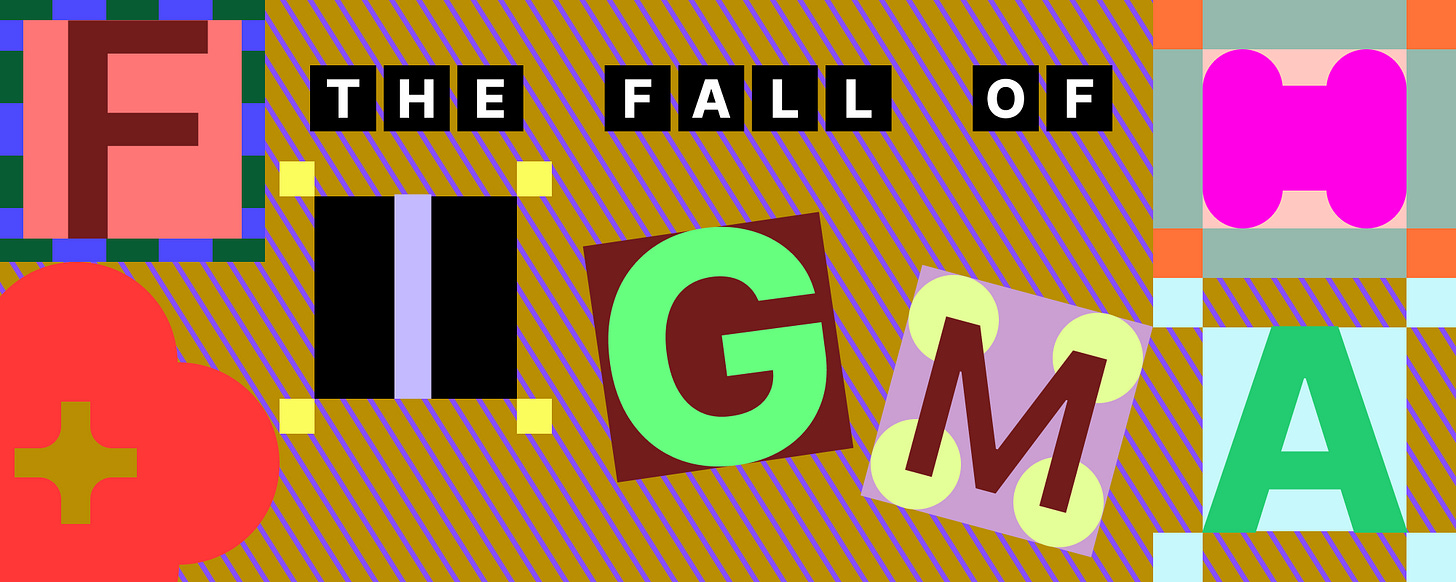
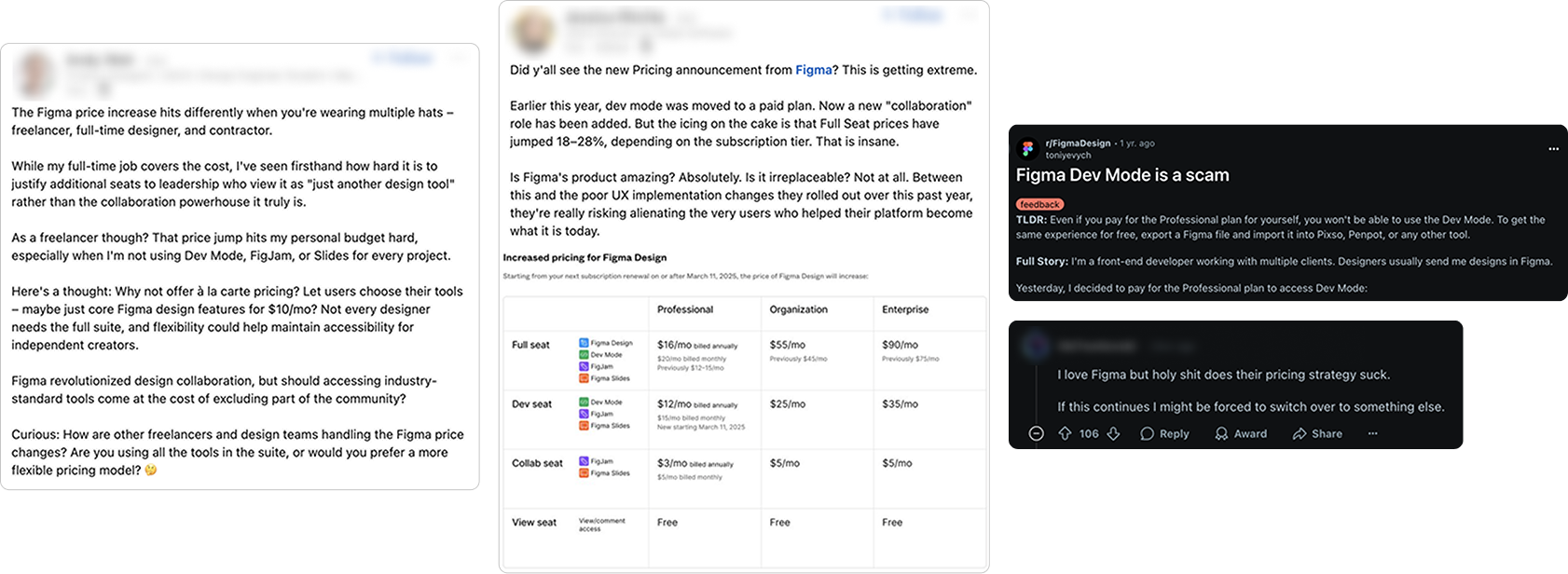
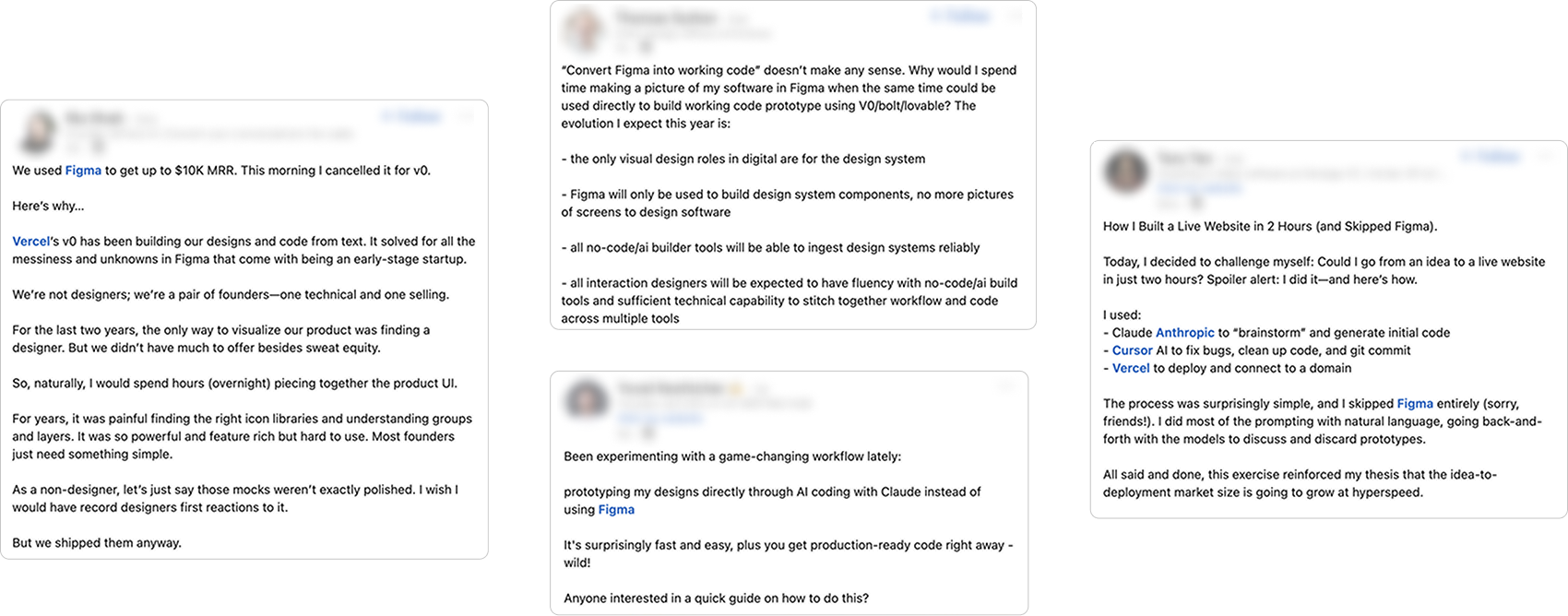
We are in the situation of the industry that no one knows what they want! I think it is too soon to talk about fall of Figma. However, we are all agree that we soon face some changes in UX. but my personal opinion is we need UX and product more than anytime. after the current AI hype by mid 2025 all companies face this reality.
I came into this field with Figma being the unspoken universal platform in design when I did my UX certification ~2 years ago. I think it was around Config that I started feel meh, but then they did a complete interface u-haul and it hasn’t been the same since 😭. I did notice that this also around the time, especially on LinkedIn, that UX Designer was becoming synonymous with being competent in Figma, like seeing Figma listed as part of the job responsibilities. In a way, Figma and people’s understanding of it and similar programs, diminished the respect and importance of our work as designers because now ‘everyone can do it’ thus an influx of people calling themselves designers, but not really understanding the entirety of UX for a role or project Being a designer is much more than just using Figma, but I think with instant gratification and reducing costs, I’m not surprised this is where we are. I am interested in trying Penpot to see how it compares to Figma.